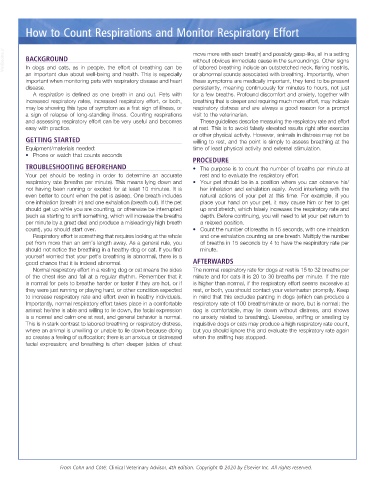Page 3193 - Cote clinical veterinary advisor dogs and cats 4th
P. 3193
How to Count Respirations and Monitor Respiratory Effort
VetBooks.ir BACKGROUND move more with each breath) and possibly gasp-like, all in a setting
without obvious immediate cause in the surroundings. Other signs
of labored breathing include an outstretched neck, flaring nostrils,
In dogs and cats, as in people, the effort of breathing can be
an important clue about well-being and health. This is especially or abnormal sounds associated with breathing. Importantly, when
important when monitoring pets with respiratory disease and heart these symptoms are medically important, they tend to be present
disease. persistently, meaning continuously for minutes to hours, not just
A respiration is defined as one breath in and out. Pets with for a few breaths. Profound discomfort and anxiety, together with
increased respiratory rates, increased respiratory effort, or both, breathing that is deeper and requiring much more effort, may indicate
may be showing this type of symptom as a first sign of illness, or respiratory distress and are always a good reason for a prompt
a sign of relapse of long-standing illness. Counting respirations visit to the veterinarian.
and assessing respiratory effort can be very useful and becomes These guidelines describe measuring the respiratory rate and effort
easy with practice. at rest. This is to avoid falsely elevated results right after exercise
or other physical activity. However, animals in distress may not be
GETTING STARTED willing to rest, and the point is simply to assess breathing at the
Equipment/materials needed: time of least physical activity and external stimulation.
• Phone or watch that counts seconds
PROCEDURE
TROUBLESHOOTING BEFOREHAND • The purpose is to count the number of breaths per minute at
Your pet should be resting in order to determine an accurate rest and to evaluate the respiratory effort.
respiratory rate (breaths per minute). This means lying down and • Your pet should be in a position where you can observe his/
not having been running or excited for at least 10 minutes. It is her inhalation and exhalation easily. Avoid interfering with the
even better to count when the pet is asleep. One breath includes natural actions of your pet at this time. For example, if you
one inhalation (breath in) and one exhalation (breath out). If the pet place your hand on your pet, it may cause him or her to get
should get up while you are counting, or otherwise be interrupted up and stretch, which falsely increases the respiratory rate and
(such as starting to sniff something, which will increase the breaths depth. Before continuing, you will need to let your pet return to
per minute by a great deal and produce a misleadingly high breath a relaxed position.
count), you should start over. • Count the number of breaths in 15 seconds, with one inhalation
Respiratory effort is something that requires looking at the whole and one exhalation counting as one breath. Multiply the number
pet from more than an arm’s length away. As a general rule, you of breaths in 15 seconds by 4 to have the respiratory rate per
should not notice the breathing in a healthy dog or cat. If you find minute.
yourself worried that your pet’s breathing is abnormal, there is a
good chance that it is indeed abnormal. AFTERWARDS
Normal respiratory effort in a resting dog or cat means the sides The normal respiratory rate for dogs at rest is 15 to 32 breaths per
of the chest rise and fall at a regular rhythm. Remember that it minute and for cats it is 20 to 30 breaths per minute. If the rate
is normal for pets to breathe harder or faster if they are hot, or if is higher than normal, if the respiratory effort seems excessive at
they were just running or playing hard, or other condition expected rest, or both, you should contact your veterinarian promptly. Keep
to increase respiratory rate and effort even in healthy individuals. in mind that this excludes panting in dogs (which can produce a
Importantly, normal respiratory effort takes place in a comfortable respiratory rate of 100 breaths/minute or more, but is normal: the
animal: he/she is able and willing to lie down, the facial expression dog is comfortable, may lie down without distress, and shows
is a normal and calm one at rest, and general behavior is normal. no anxiety related to breathing). Likewise, sniffing or smelling by
This is in stark contrast to labored breathing or respiratory distress, inquisitive dogs or cats may produce a high respiratory rate count,
where an animal is unwilling or unable to lie down because doing but you should ignore this and evaluate the respiratory rate again
so creates a feeling of suffocation; there is an anxious or distressed when the sniffing has stopped.
facial expression; and breathing is often deeper (sides of chest
From Cohn and Côté: Clinical Veterinary Advisor, 4th edition. Copyright © 2020 by Elsevier Inc. All rights reserved.

